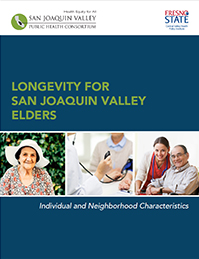Central Valley Health Policy Institute
Longevity for Elders

Individual and Neighborhood Characteristics
The United States and other industrialized counties have experienced notable improvements in the length of life, and about 81% of US residents are expected to live past age 65. Public health initiatives, such as improvements in sanitation, control of infectious disease and improved nutrition have been key factors. Improvements in life expectancy, since the 1930’s, are attributed to health care access and lifestyle behaviors. Despite overall increases in the length and quality of life for older people, broad differences across gender racial/ethnic, social class, neighborhood design and rural-urban residence have been found. Findings on the influence of diverse potentially modifiable factors on elder health outcomes indicate the potential for continued improvements. This report examines the determinants of longevity for San Joaquin Valley (SJV) persons aged 65 and older in relation to individual, health care, and neighborhood factors. Although examining patterns of survival and death for elders does not provide a complete picture of the overall health of older adults in the region, understanding longevity determinants can help identify priorities for public health.
Older Adult Longevity: Multiple Determinants
The number of years a person is likely to live (life expectancy) has been examined from multiple perspectives. Although there is consensus that genetic factors are determinants of longevity, specific pathways have not been identified. Further, there is increasing evidence for epigenetic (interactions of genes with environment or behavior factors) determination of longevity and thus the continuing attention to other potential causes. Four groups of determinants have been highlighted in prior studies:
- Individual demographics: For older adults in this country, individual factors such as gender, race/ethnicity, education and wealth have been linked to longevity, functional status, and quality of life. Populations with greater economic security live longer and report greater health and well-being including Asian Americans, older whites, women and those with more education. Notably, consideration of other factors, such as individual health behaviors or health care use, tends to reinforce the influence of demographic differences. For elders, demographic categories serve as proxy measures of a life-time of differential exposure to living condition, health events and interventions, social supports, and other sources of stress and resilience, all closely associated with different demographic positions in the society.
- Health related behaviors: Current and lifetime health risk behaviors, such as smoking, diet, exercise, substance use, and social support have been consistently linked to health outcomes. The influence of these factors appears smaller for elders than for younger persons; they are increasingly recognized as at least partially a response to neighborhood stressors. Health risk behaviors can change even in old age, and there is convincing evidence that smoking cessation, weight management and physical activity interventions can improve health and survival.
- Health services use: For older adults, the accessibility and quality of medical care has been associated with longevity and quality of life. Older adults who receive higher frequency and quality of primary medical care experience lower mortality. Older persons with greater access to primary care are less likely to have avoidable hospitalizations. There are broad social group and market-area differences in rates for surgeries both elective and mandatory that may better reflect differences in practice patterns or insurance than underlying medical necessity.
- Neighborhood environment: Because individual demographic and health risk behaviors in elders reflect both cumulative life experiences and current exposures, they have been found to be the most powerful predictors of longevity among elders. Researchers, nonetheless, have consistently found impacts of multiple neighborhood features on longevity. Neighborhood socio-economic status has been found to be an independent predictor of heart disease mortality and all-cause mortality. Racial/ethnic and economic segregation at the neighborhood level has also been linked to life expectancy and mortality for elders.
Read the full introduction